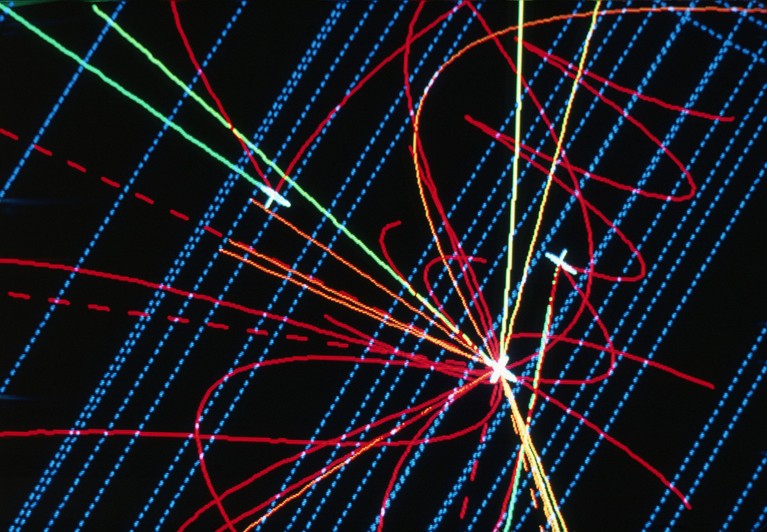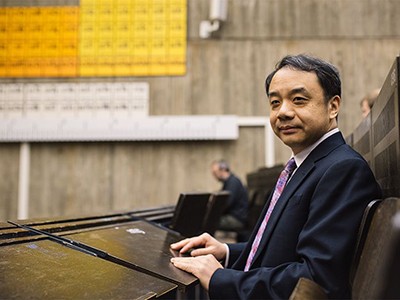
Computer simulation of an electron-positron collision. The blue lines represent part of the detector. The variously coloured lines are the tracks of particles created in an electron-positron annihilation. The solid lines represent charged particles, which bend in the detector’s magnetic field. The broken lines represent neutral particles, which are unaffected by the magnetic field.Credit: Philippe Plailly/Science Photo Library
China hopes to build a US$5-billion particle smasher within three years — beating Europe’s proposed mega-collider to the punch. The 100-kilometre Circular Electron Positron Collider (CEPC) would aim to measure the Higgs boson — a mysterious particle that gives everything mass — in exquisite detail. Such information could answer fundamental questions about how the Universe evolved and why particles interact in the way that they do.
Next year, the proposal for the CEPC will go before the Chinese government for possible inclusion in its next five-year plan. If it can win government support, construction could begin in 2027 and would take around a decade, according to a comprehensive technical-design report published on 3 June1. The report estimates that the supersized collider would cost 36.4 billion yuan (US$5.2 billion), which would make it considerably cheaper to build and run than Europe’s US$17 billion Future Circular Collider (FCC). Construction on the European facility will begin in the 2030s if it receives government approval.
Inside its enormous underground tunnel, the CEPC would smash together electrons and their antiparticles, positrons, at extraordinarily high energies to generate millions of Higgs bosons. The sheer number of them would allow researchers to study the particle in greater detail than ever before, says Andrew Cohen, a theoretical physicist at the Hong Kong University of Science and Technology. By measuring the Higgs more precisely, researchers will be able to probe questions that reach beyond the Standard Model — the leading but incomplete theory of what the cosmos is made of — such as the nature of dark matter and why there is more ordinary matter than antimatter in the Universe.

Inside the plans for Chinese mega-collider that will dwarf the LHC
The latest report includes a detailed blueprint of the accelerator’s layout design and component prototypes, says physicist Wang Yifang, director of the Chinese Academy of Science’s Institute of High Energy Physics in Beijing. It also includes assessments of three potential sites: Qinhuangdao, Changsha and Huzhou. “We are now confident this is a real machine that we can build,” says Wang.
Many of the components that are planned for China’s mega machine are already being tested at other facilities in the country, says Frank Zimmermann, a physicist at CERN, Europe’s particle-physics laboratory near Geneva, Switzerland. Among these are the near-complete High Energy Photon Source in Beijing. Given that China is already home to a collider that is similar to the CEPC — the Beijing Electron Positron Collider — the country might now have more expertise in this area than does all of Europe combined, says Zimmermann, who chaired the review committee for the CEPC’s technical-design report and is also involved in the FCC. “They made big progress,” he says.
Help from abroad
Table of Contents
The technical-design report demonstrates that China is capable of building the CEPC’s accelerator with little assistance from international researchers, says Cohen, a member of the CEPC International Advisory Committee. “If they want to build the accelerator and move forward, they can.” But he adds that China will probably need to draw on outside expertise to develop the collider’s detectors, which were not the focus of the report.
Another hurdle the CEPC could face is attracting funding from other countries in light of ongoing geopolitical tensions, says Tian Yu Cao, a historian and philosopher of particle physics and quantum field theory at Boston University in Massachusetts. “I think that there will be greater resistance from the West to help China,” says Cao.

CERN’s $17-billion supercollider in question as top funder criticizes cost
But the challenge of securing international funding isn’t unique to China. In May, the German government said it would not pay its portion of the FCC’s US$17 billion price tag, which was a big setback for the project.
However, Wang is confident that the CEPC will be an international effort. He points out that international researchers already account for 30% to 50% of teams working at some of China’s massive physics facilities — among them the Jiangmen Underground Neutrino Observatory in Kaiping, which is due to start running this year. “We believe [the CEPC] is going to be similar,” he says.
In the meantime, Wang and his team are working on an engineering-design report that will outline the construction of the CEPC in more detail. “We are trying to make sure we are fully ready for such a project,” says Wang.
